Community Dental Health

- Cover Date:
- June 2007
- Print ISSN:
- 0265 539X
- Vol:
- 24
- Issue:
- 2
Challenges associated with the evaluation of a dental health promotion programme in a deprived urban area
Objective This paper reports the results of a community trial to measure the clinical impact of a linked series of interventions on Early Childhood Caries (ECC) and general caries levels among five-year-old children. It exemplifies the problems of undertaking population based interventions in deprived communities. Research design Two health districts (Primary Care Groups) were matched for dental disease levels and socio-demographic factors. One was randomly allocated to be the active intervention PCG, the other the comparison PCG. Children in the active PCG received a series of interventions to support positive dental health behaviour from the age of 8 to 32 months. Clinical examinations were undertaken on a cohort of 5-year-old children in both active and comparison PCGs. Setting In the active PCG, children who attended designated clinics for their 8-month developmental checks and/or MMR inoculations at 12 to 15 months, were given gift bags, the first contained a trainer cup, the second fluoride toothpaste (1450 ppm F) and toothbrush. Parents were also given written, pictorial and verbal advice on oral care. Further supplies of toothpaste and brushes were posted to the children’s homes at 20, 26 and 32 months. When five years of age children in the two PCGs were examined in school. Outcome measures Severity and prevalence of ECC and general caries. Levels of participation. Results Among participants in the active PCG the prevalence of ECC, general caries and extraction experience and mean dmft (20%: 54%: 3%: 2.2) were lower than in ‘participants’ in the comparison area (32%: 64%: 12%: 3.7). All differences were statistically significant. When all children (participants and non-participants) in the two PCGs were compared, the differences were much reduced (30%: 63%: 6%: 3.1 vs. 32%: 64%: 12%: 3.6). A higher proportion of children in the active PCG area (47%) were found not to have participated in the interventions, when compared to 21% in the comparison area. Disease levels in the non-participants in the active PCG were particularly high. The impact of participation bias, changes in baseline balance, population mobility and alternative study design on outcomes are explored. Conclusion The impact of non-participation in a deprived, urban conurbation with high levels of population mobility are sufficient to dilute the impact of a health intervention such that few benefits are discernible at a population level.
Key words: caries, dental health promotion, participation, research methodology
- Article Price
- £15.00
- Institution Article Price
- £
- Page Start
- 117
- Page End
- 121
- Authors
- G.M. Davies, J.T. Duxbury, N.J. Boothman, R.M. Davies
Articles from this issue
- Title
- Pg. Start
- Pg. End
- The cost-effectiveness of adding fluorides to milk-products distributed by the National Food Supplement Programme (PNAC) in rural areas of Chile
- 75
- 81
- Dietary patterns, toothbrushing habits and caries experience of schoolchildren in West Yorkshire, England.
- 82
- 87
- Prevalence and severity of dental caries in 5- and 12-year old children in the Veneto Region (Italy)
- 88
- 92
- Reliability methodology in caries epidemiological studies conducted in the Nordic countries between 1990 and 2001
- 97
- 104
- The reproducibility of the Denplan Oral Health Score (OHS®) in general dental practitioners
- 105
- 110
- Challenges associated with the evaluation of a dental health promotion programme in a deprived urban area
- 117
- 121
- Dental caries and associated factors among young male adults between 1999 and 2003 in Southern Brazil
- 122
- 127
